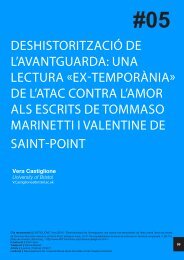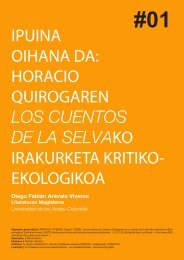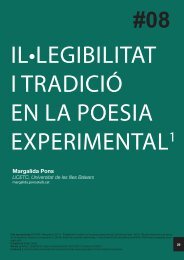Etxeita wrote a more idealized-costumbrista novel in 1910: Jaioterrimaitia (Beloved Homeland), which no longer makes reference tohis imperialist past in the Philippines thus completing his colonialdisavowal, while rendering the Basque migrant into a fully ahistorical,representational colonial subject: the novel takes places in themountains, in a village called Ardibaso. Instead of the Philippines,Mexico becomes the new site of colonial disavowal: three couplesfrom Ardibaso migrate to Mexico, make their fortunes, and return to thevillage, without ever interacting in a meaningful way with any Mexicancharacter. The three couples only deal with each other and otherBasque emigrants in what can only be called a “Mexican Ardibaso”(mostly located in Veracruz). In short, even the Mexican postcolonialspace becomes fully Basquized in order to disavow fully colonialism/imperialism: Mexico is not the Basque Country, but just the same.In order to understand the full extent of Etxeita’s disavowal ofhistorical colonialism, it is important to resort to this very colonialhistory and, more specifically, to the colonial history of the Basquesin the Philippines. After sixty years of monopolistic activity (1728-1785) in Venezuela, the Real Compañía Guipuzcoana de Caracas, aBasque colonialist monopoly, lost its hold of the Venezuelan market,due in part to its exploitative and abusive methods, and found itselflooking for other monopolist markets. As Marciano de Borja explainsin his The Basques in the Philippines, the Spanish monarchy grantedthe same company the colonial market of the Philippines and so theReal Compañía de Filipinas was born in 1785 (2005: 66-74), whichdid not compete with the «Galeón de Acapulco» as it took the Easternroute through Cape of Good Hope.. As a result, Basque colonialisthistory took root in the Philippines. Although this company ended in1837, the Basque presence among the local Spanish elite grew. ABasque, Antonio Ayala, founded and expanded, with other Germanand Spanish partners, what became the Ayala Corporation—stilltoday the largest company in the Philippines (De Borja, 2005: 124-27). Moreover, and as Etxeita’s biography confirms, another Basquecompany, Olana, Larrinaga and Co., ran the only shipping route fromEngland to the Philippines. Historically, the Basque elite had a centralposition in Manila and, more generally, in the colony at large. As I willexplain later when analyzing Rizal’s work, it is important to emphasizethat this elite was recognized as distinctively Basque (the Spanishcolonizer of the Philippines was also Basque, Lope de Legazpi).Galdós, Etxeita, Rizal – Madrid, Mundaka, Manila: On Colonial Disavowal and (Post) Imperial Articulations of the Hispanic Pacific-Atlantic - Joseba Gabilondo<strong>452ºF</strong>. #09 (2013) 13-41.Etxeita’s biography is central to the above history of Basque colonialism.He became a sea captain at the age of 20 and started to work forthe Basque shipping company located in Liverpool, Olana, Larrinagaand Co, which ran the route between Liverpool and Manila. Etxeitaeventually settled down as the agent of the company in Manila and laterwas promoted to the position of president. After gaining membershipin several advisory boards in Manila, he also became the president of34
the local chamber of commerce and finally the mayor of the capital.He lived in Manila for 16 years. In 1898, he returned to his hometownMundaka where he spent the rest of his life (Kortazar, 1999: 8).As I stated earlier, it is only after Etxeita left the Philippines in1898 and settled in his native Mundaka, that he began to write inBasque (Josetxo 1909; Jaioterri maitia 1910; Au, ori ta bestia 1913).Therefore the switch to Basque language, to the local indigenouslanguage—to his own Basque “Tagalog,” as it were—is the cruciallinguistic and literary device that allows Etxeita to perform hismaneuver of colonial disavowal. Josetxo borrows from his earlierfictionalized biography in Spanish, but it becomes fully fictional ina very crucial element: the haunting absence of the Philippines,which only emerges at the very end of the novel to completeprecisely a post-imperial-colonial fantasy of «yes but just thesame»: the hero’s unknown father appears at the end to give hima Basque paternity and, with the fortune that the father made in thePhilippines, also endow the son with a new (petty) bourgeois lineage.Josetxo is an indiano novel and fantasy. The protagonist, Josetxo,is snatched by gypsies and grows poor with his adoptive familyin Mundaka. Due to his great abilities and good disposition, hebecomes captain of a ship and owner of a small fortune by agetwenty. Due to a shipwreck, he ends up in Argentina and after strikinga filial relationship with a rich Basque hacienda owner, he becomesthe overseer of the hacienda and several years later, returnsas the richest man of Mundaka. Finally, he marries his childhoodsweetheart, who has suffered and resisted for years all the attemptsmade by her evil parents to marry her to other men who werericher than Josetxo and had a well-established origin in the village.The sentimental subplot, based on his own life, and which alreadyappeared in his first semi-autobiographic novel in Spanish, furtheremphasizes colonial disavowal. Josetxo, unlike Etxeita, is a boykidnapped and abandoned by a “gypsy” woman; thus his originsand Basque filiation are put into question by the novel. Againstthe opposition of Josetxo’s adoptive family who wants to marryhim to a richer girl, Josetxo’s girlfriend, Eladi, awaits faithfully hisreturn as he navigates and endures shipwrecks throughout theworld. After a long absence Josetxo returns, now rich, and marriesEladi. In short, colonial disavowal also takes an emotional andaffective turn, as Josetxo marries the right «colonial» woman, aBasque woman who is even bound by blood—she is his cousin.Here, semi-incestuous relationships further emphasize colonialdisavowal, as the love between both heroes is thickened byblood. In Amoríos de Juana y Manuel, at the end of the novel,the mother supplants the girlfriend as the final emotional instanceof colonial disavowal: Josetxo ultimately returns to his mother.Galdós, Etxeita, Rizal – Madrid, Mundaka, Manila: On Colonial Disavowal and (Post) Imperial Articulations of the Hispanic Pacific-Atlantic - Joseba Gabilondo<strong>452ºF</strong>. #09 (2013) 13-41.35
- Page 1 and 2: 452ºF452ºF OriginalIssueVersióno
- Page 3 and 4: EDITORIAL en-452ºF Literaturaren T
- Page 5 and 6: EDITORIAL es-452ºF Revista de Teor
- Page 7 and 8: EDITORIAL ca-452ºF Revista de Teor
- Page 9 and 10: LAEDITORIA-eu-452ºF Literaturaren
- Page 11 and 12: 13 42 56JOSEBAGABILONDOGaldós, Etx
- Page 13 and 14: GALDÓS, ETXEITA,RIZAL - MADRID,MUN
- Page 15 and 16: The bullion [of silver coming from
- Page 17 and 18: Although Paul Gilroy’s disregard
- Page 19 and 20: Fortunata and Jacinta (1886-87), to
- Page 21 and 22: corresponde rigurosamente a la dial
- Page 23 and 24: the bourgeoisie, so that the former
- Page 25 and 26: los decía con desdén a la clase m
- Page 27 and 28: café culture and Galdós’s natur
- Page 29 and 30: itself as nation-state or, in Blanc
- Page 31 and 32: disavowal at the core of their nove
- Page 33: force; the latter is always mention
- Page 37 and 38: century in a double colonial geogra
- Page 39 and 40: spaces of dominated nationalism suc
- Page 41 and 42: JUARISTI, J. (1997): El bucle melan
- Page 45 and 46: Euskal Herriko sasietako urretxindo
- Page 47 and 48: Bizkitartean non daude euskal nobel
- Page 49 and 50: XX. mendeko emakume euskaradunen li
- Page 51 and 52: Aukeratu ditugun emazte idazleen te
- Page 53 and 54: prozesu fisiologiko horretaz.Emakum
- Page 55 and 56: BibliografiaAGIRRE, Katixa (2009):
- Page 57 and 58: 452ºFLaburpena || Bere burua euska
- Page 59 and 60: apologisten pentsamendu mitologiko
- Page 61 and 62: dezakegu mende bat beranduago, Grat
- Page 63 and 64: deritzolako desiragarri begirada ko
- Page 65 and 66: abian jarriko duten idazleek Sabino
- Page 67 and 68: Txillardegik ETA erakundearen sorku
- Page 69 and 70: Halere, historiak, batzuetan totelk
- Page 71 and 72: literarioa aniztu ahala- pixkanaka
- Page 73 and 74: ondorio. Atxagari dagokionean, berr
- Page 75 and 76: delako aspalditxotik, eta euskal po
- Page 77 and 78: BibliografiaATXAGA, B. (1982): «Eu
- Page 79 and 80: 452ºFLaburpena || Artikulu honen x
- Page 81 and 82: expresa por medio de enigmas y mist
- Page 84 and 85:
erezia» (Atxaga et al., 1975). Min
- Page 86 and 87:
poesía irrealista y evasiva, forma
- Page 88 and 89:
lotzeko nahia agertzen baita: «Mun
- Page 90:
du, hain zuzen, literatur historia
- Page 93 and 94:
kostaldeko iruditeria goibela hartz
- Page 95 and 96:
POESÍA CORPORAL/DANZA VERBAL:UNA L
- Page 97 and 98:
0. IntroducciónEn este trabajo vam
- Page 99 and 100:
Sarrionandia―).2. El imaginario p
- Page 101 and 102:
coreografía nos remite a la textua
- Page 103 and 104:
pero eso sí, los poemas se escucha
- Page 105 and 106:
y tienen voz. Ixiar Rozas (2011) en
- Page 107 and 108:
aile, una voz en off recita parte d
- Page 109 and 110:
iniciativas culturales de las compa
- Page 111 and 112:
POÉTICA DERESISTENCIAEN ITXAROBORD
- Page 113 and 114:
Itxaro Borda (pseudónimo de Bernar
- Page 115 and 116:
haber sentido de niña), permiten
- Page 117 and 118:
Percibía la paz.Sigo dando a verLo
- Page 119 and 120:
Poética de resistencia en Itxaro B
- Page 121 and 122:
ilingüe «Otsude nago», transferi
- Page 123 and 124:
BibliografíaAPALATEGI, U. (2008):
- Page 125 and 126:
normal en lenguas nacionales o inte
- Page 127 and 128:
452ºFLaburpena || Bakartasuna da I
- Page 129 and 130:
1. Zedarri zenbait1. 1. Bakartasuna
- Page 131 and 132:
Bakartasuna plurala eta paradoxikoa
- Page 133 and 134:
eta pertsonaien misantropia azaleko
- Page 135 and 136:
Walter Benjaminek -Benjamin, 1972:
- Page 137 and 138:
modu paradoxiko batean, (Euskal) ko
- Page 139 and 140:
BibliografiaItxaro Bordaren liburua
- Page 141 and 142:
Nouvelle Revue de Psychanalyse (198
- Page 143 and 144:
PERIFÉRICABLVD. O UNA(NEO)BARROCAP
- Page 145 and 146:
No deja de ser una comprobación de
- Page 147 and 148:
Puede decirse, así, que Periféric
- Page 149 and 150:
1. Un policial contra el policialCo
- Page 151 and 152:
-Che, campestre, ¿dónde te metes?
- Page 153 and 154:
tener, y si bien el lector tiende,
- Page 155 and 156:
de ciudad, diría Rama). Dos formas
- Page 157 and 158:
posible, representada e inventada,
- Page 159 and 160:
No puedo dejar de enfatizar, así,
- Page 161 and 162:
BibliografíaARECO, M. (2011): «Ca
- Page 163 and 164:
452ºFAbstract || It is a truth uni
- Page 165 and 166:
naturalistic or empiricist literary
- Page 167 and 168:
enemy in the 1984 TV series—with
- Page 169 and 170:
gain control. The most evident case
- Page 171 and 172:
ipped John’s mask off in front of
- Page 173 and 174:
Anna: Nothing’s too complex for o
- Page 175 and 176:
originally conceived as a prequel t
- Page 177 and 178:
as “made of lead,” is responsib
- Page 179 and 180:
other opening the casket is pivotal
- Page 181 and 182:
a case of mistaken identity. I’m
- Page 183 and 184:
GALLARDO, X. C. and SMITH, C. J. (2
- Page 185 and 186:
Mireia Martín
- Page 187 and 188:
Nuevas subjetividades/Sexualidades
- Page 189 and 190:
Islas imaginadasLuz C. Souto452ºF










